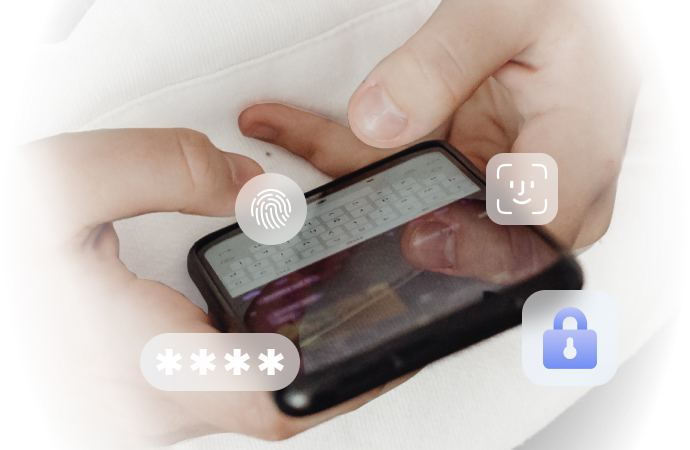
How to Troubleshoot and Remove Configuration Profiles on iPhone and iPad
Oct 13, 2025 • Filed to: Screen Lock Removal • Proven solutions
We’ve all downloaded apps from the App Store, but most of us haven’t had to deal with configuration profiles or iPhone profiles on our devices in everyday life.
When your IT department sends you an email asking you to install a configuration profile on your work phone, or when you try to download an app and get a prompt from Apple asking if you want to install a configuration profile, you might wonder: what is a configuration profile? Why should you install it? And if you decide you don’t want it on your device, how can you remove the configuration profile from your iPhone or iPad?
This article will answer all these questions. Let’s explore configuration profiles together and learn how to manage them on your iPhone or iPad!
Part 1: What is a Configuration Profile?
Configuration profiles are XML files that you can install on your Apple device to manage its settings. These iOS configuration profiles may include data, settings, and apps. They’re also used in Apple’s developer and public beta programs. They can adjust how your device handles Wi-Fi, email accounts, passwords, data, and other features. Businesses and schools often use them to manage their members’ accounts and devices.
Although configuration profiles help manage your Apple device, they come with certain risks. They can alter passcode settings, monitor your network data, or redirect your device to harmful websites.
It’s crucial to ensure that the configuration profile you plan to download is safe before installing it on your iPhone or iPad. Here are some common types of configuration profiles:
- Device Management: These profiles allow organizations to apply security policies, configure VPN settings, and manage apps remotely.
- Email Settings: Configuration profiles can set up email accounts by configuring server details and security settings, making the process easier.
- Security Settings: These profiles enforce security measures like passcode requirements, encryption, and restrictions on device features.
Part 2: Why Remove a Configuration Profile?
You may want to eliminate a configuration option on your iPhone or iPad for multiple reasons. Here are a few everyday situations:
Freedom from Limitations: Configuration profiles can limit many things, like the number of apps installed or websites accessed. By deleting the profile, you can circumvent these limits and regain complete control of your device.
Performance of the Device: Configuration profiles can slow down your device by forcing unnecessary choices. Taking them off can help your device work better.
Leaving a Company: If you've left a company that put a setup profile on your device, you might not need that profile anymore. If you remove it, your device will return to its previous state without management controls.
Part 3: Why a Configuration Profile Won't Delete from Your iPhone
Sometimes you cannot remove a configuration profile from your iPhone. Now, let's examine several potential explanations for this situation.
No Configuration Profile Present:
Not all restrictions are caused by a configuration profile. If you don’t see one in your Settings app, the issue might be due to something else.
App Not Deleted:
Some configuration profiles are linked to specific apps. To fully remove the configuration profile from your iPhone, you must also delete the associated app.
iPhone Not Restarted:
After deleting a configuration profile, it might still appear until you restart your iPhone to refresh the settings.
No Account or Passcode:
You may need the account and passcode used to install the profile. Without these credentials, you cannot remove the configuration profile or device management profile from your iPhone.
Unremovable Profile:
Some profiles are designed to prevent removal. If you encounter such a profile, you won’t be able to remove it from your device.
Part 4: How to Remove a Configuration Profile from Your Phone/iPad
Way 1: Remove a Configuration Profile from Your Phone/iPad Using Settings
Now that you understand a configuration profile and how it works, you should know how to check and remove it from your iPhone. Follow these easy steps to find and remove the profile.

Step 1: Open Settings and Access General
Open the Settings app and tap on General. Continue scrolling until you locate the section labeled Profiles & Device Management.
Step 2: Select the Profile to Remove
You will see all the profiles installed on your iPhone. Select the profile you wish to delete and tap on Remove Profile.
Step 3: Enter Passcode and Confirm
Enter your device passcode when asked, then tap Remove.
Step 4: Restart Your iPhone/iPad
Restart your iPhone/iPad. The profile will be deleted upon the reboot.
Way 2: Remove Configuration Profiles from iPhone or iPad with Apple School Manager
If you cannot remove the configuration profile from your iPhone or iPad, Apple School Manager provides an easy solution. This method also works with Apple Business Manager or Apple Business Essentials. You can effortlessly locate your supervised device and delete the configuration profile using Apple School Manager or Apple Business Manager. The following are the steps to remove a configuration profile using Apple School Manager.

Step 1: Sign In to Apple School Manager
Use your administrator keys to log in to Apple School/Business Manager or Apple Business Manager.
Step 2: Access the Devices Section
Next, click the "Devices" button in the sidebar to find and view your device.
Step 3: Select Your Device
After locating your device, select it and carefully review the information provided.
Step 4: Confirm and Release the Profile
Finally, check the notification box and click the "Release" button to remove the configuration profile from your device.
Way 3: Remove Configuration Profile from iPhone Using Apple Configurator
If you need to remove a configuration profile from your iPhone, and the device is supervised with Apple Configurator, you can use Apple Configurator to do this. However, make sure to back up your device first. Follow these steps to remove the profile using Apple Configurator:

Step 1: Launch Apple Configurator
Open Apple Configurator on your computer. Use a USB connector to establish a connection between your iPhone and your PC.
Step 2: Detect Your Device
Wait until Apple Configurator detects your iPhone. Hit the Device button when it becomes visible.
Step 3: Access Advanced Options
At the top of the window, click on Actions. Next, choose the option labeled "Advanced" from the menu that appears.
Step 4: Erase Content and Settings
Click on the Erase All Content and Settings button to remove the configuration profile from your iPhone.
This method is effective when you cannot manually remove the configuration profile from your iPhone. Ensure you have a data backup, as this process will erase all content on the device.
Way 4: Remove Configuration Profile from iPhone with a Factory Reset [Data Loss]
When you cannot remove a configuration profile from your iPhone, you can use a factory reset to delete it. Follow these steps:

Step 1: Open Settings
Go to Settings, then tap General. Select Transfer or Reset iPhone.
Step 2: Erase All Content and Data
Choose Erase All Content and Data, then tap Continue.
Step 3: Skip iCloud Backup
Bypass the iCloud Backup choice and input your screen password.
Step 4: Start the Erase Process
Tap Erase Now to begin deleting the configuration profile.
Step 5: Confirm the Reset
Tap Erase again to confirm and reset your device to the factory settings.
After completing these steps, set up your iPhone as new. Avoid choosing Restore from iCloud Backup to ensure the configuration profile is fully removed.
Part 5: Bonus Method: Remove Management Profile via Dr.Fone - Screen Unlock (iOS)
5.1 What is MDM?
MDM stands for Mobile Device Management. It is a system that lets administrators control iOS devices from a central server. With MDM, admins can remotely manage iPhones and iPads. They can view, delete, or install profiles, remove passcodes, and even erase devices.
5.2 How Dr.Fone Can Help
Dr.Fone - Screen Unlock (iOS) is a tool for removing or bypassing remote iPhone MDM. Unlike other tools, Dr.Fone ensures that your data remains safe during the process. It is a reliable choice for unlocking various locks on your device.

Dr.Fone - Screen Unlock (iOS)
Bypassing Remote iPhone MDM.
- Simple, click-through, process.
- Unlock screen passwords from all iPhones and iPads.
- No tech knowledge is required, everybody can handle it.
- Supports the latest iOS version fully!

5.3 Key Features of Dr.Fone
- Take off every lock screen from your iPod, iPad, and iPhone.
- Skipping the iCloud activation lock and Apple ID requires no password.
- Bypass MDM and screen time restrictions without losing any data.
- Fully integrated with the iPhone 15, iPadOS 17, and iOS 17.
- Easy 3-step process that requires no technical knowledge.
5.4 Issues with Removing Configuration Profiles
If you cannot remove the configuration profile from your iPad or iPhone, Dr.Fone can help resolve this problem. The tool is designed to handle scenarios where you need to remove the configuration profile from your iPhone or iPad efficiently and safely.
5.5 Easy Steps to Use Dr.Fone iPhone Unlocker
Even if you are new to this, Dr.Fone iPhone Unlocker is straightforward to use. It works on both Windows and macOS. Here’s how to get started:
Step 1: Launch the Tool
- Open Wondershare Dr.Fone on your computer.
- Go to Toolbox.
- Select Screen Unlock.
- Choose iOS to open the tool.

Step 2: Start Unlocking the MDM Function
- Find the Unlock MDM iPhone option.
- Click on this option to begin unlocking the MDM lock on your device.

Step 3: Choose Bypass MDM
- On the next screen, select Bypass MDM from the two options available.
- Click Get Started at the bottom-right of the screen.
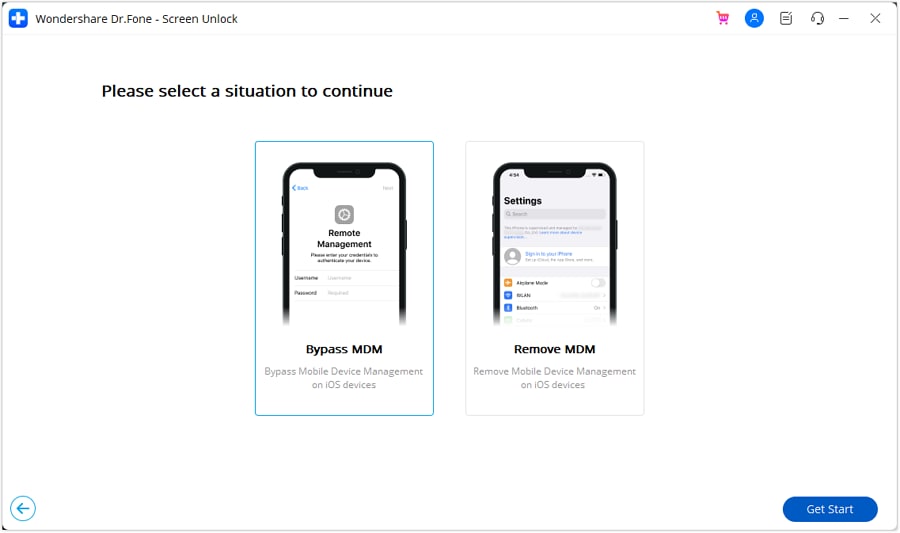
Step 4: Proceed to Bypass the MDM Lock
- A new screen will appear.
- Click Start to Bypass to begin the unlocking process.
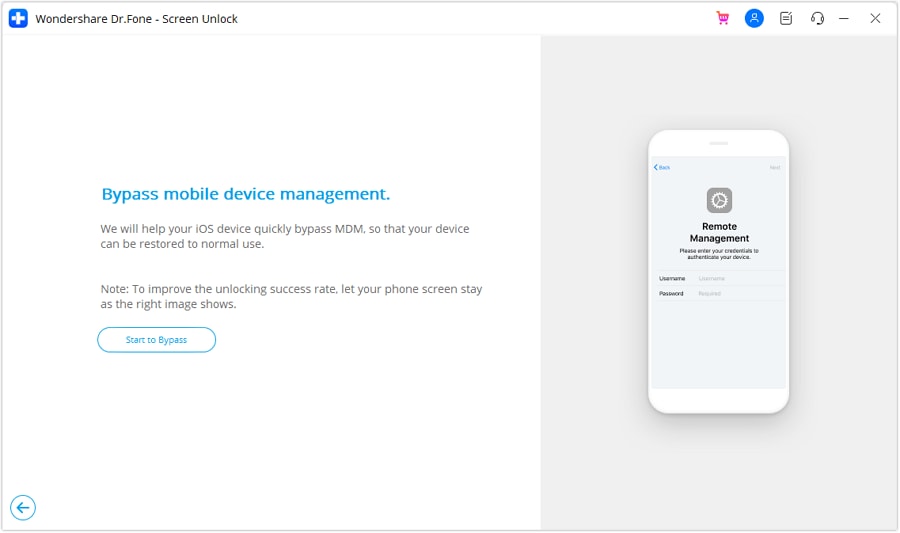
Step 5: Turn Off Find My Feature
- You will be asked to disable the Find My feature on your iPhone or iPad.
- Navigate to the Settings menu and select your name located at the top.
- Select iCloud.
- Turn off Find My from the list of options.
- Confirm by clicking OK on your computer screen.
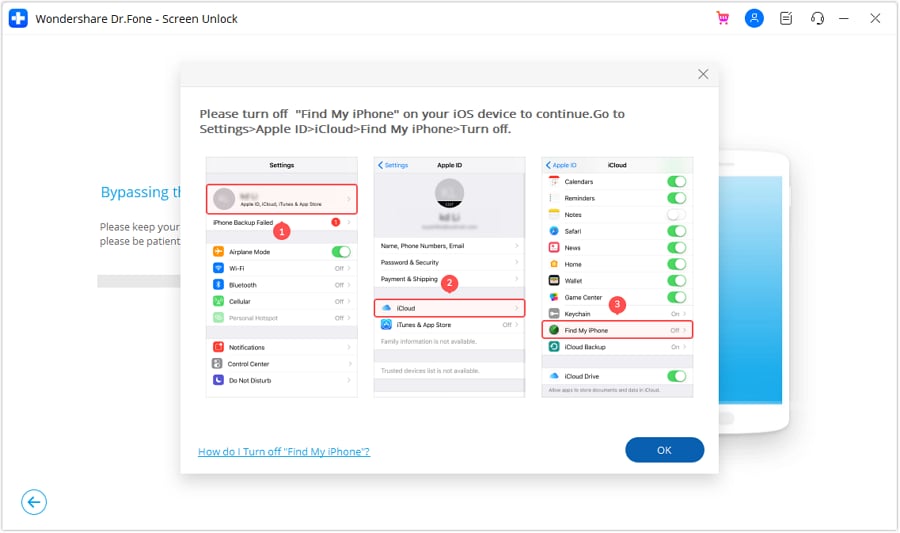
Step 6: Monitor the Bypass Progress
- Dr.Fone will start bypassing the remote MDM lock.
- Watch the progress on the screen.
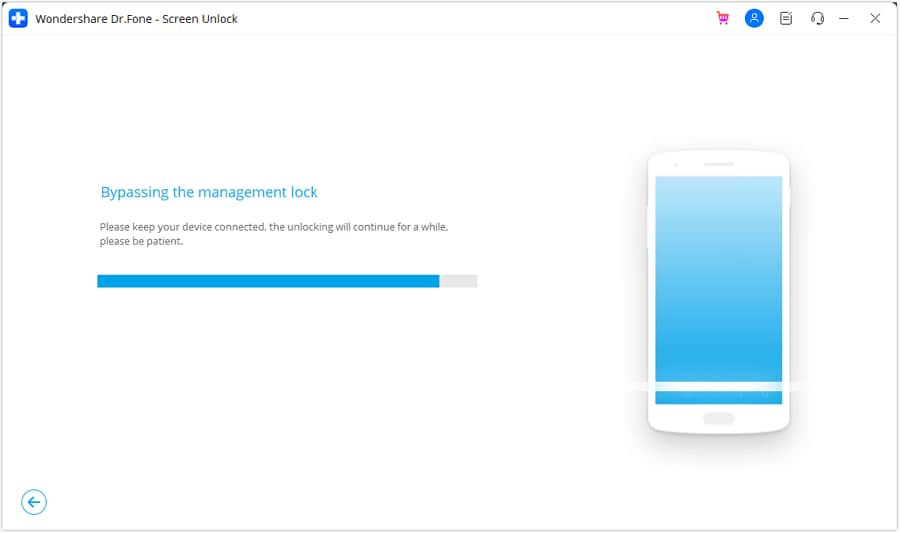
Step 7: Complete the Bypass
- Upon completion of the steps, a success message will be displayed.
- Click Done to close the window.

Conclusion:
Configuration profiles are helpful in managing and controlling iPhones and iPads, but they can become restrictive, especially if you’re no longer part of the organization that set them up. Whether you’re dealing with a situation where you cannot remove a configuration profile from an iPad or simply want to regain control over your device, the methods outlined in this guide will help you remove these profiles. When standard methods fail, Dr.Fone - Screen Unlock (iOS) provides a reliable solution to remove configuration profiles from your iPhone or iPad.
FAQs
- No Profiles and Device Management Option: If you don't see the Profiles & Device Management option in Settings, your device does not have a profile installed.
- Forgetting to Restart: Sometimes, you need to restart your iPhone after removing a profile. Failing to do so might prevent the profile from being fully deleted.
- App Not Removed: If the app associated with the configuration profile hasn't been deleted, the profile removal might not be complete.
- Profile restrictions: Some profiles are designed to be non-removable. In such cases, you cannot delete them yourself.
- Need for Third-Party Tools: If the profile is unremovable, you might need to use a tool like Dr.Fone - Screen Unlock (iOS) for assistance.
- Remove the app: Go to your home screen. Long-press the application icon until it initiates a shaking motion. Tap the x icon and then select Delete.
- Delete the profile: Open Settings. Go to General, then Profiles & Device Management. Find the profile related to the app. Tap on the option and choose the "Delete Profile" action.
- Restart Your iPhone: Finally, restart your iPhone to complete the profile deletion.
iPhone Unlock
- Access Locked iPhone
- 1. Reset Locked iPhone Without iTunes
- 2. Erase Locked iPhone
- 3. Get Into Locked iPhone
- 4. Factory Reset Locked iPhone
- 5. Reset Locked iPhone
- 6. iPhone Is Disabled
- 7. Fix iPhone Unavailable Issue
- 8. Forgot Locked Notes Password
- 9. Unlock Total Wireless Phone
- 10. Review of doctorSIM Unlock
- iPhone Lock Screen
- 1. Lock Apps on iPhone
- 2. Bypass iPhone Passcode
- 3. Unlock Disabled iPhone Without PC
- 4. Disable One More Minute Screen Time
- 5. Unlock iPhone Passcode Screen
- 6. Reset iPhone Password
- 7. Auto Lock Never on iPhone
- 8. Remove Carrier Lock/SIM Restrictions
- 9. Get iMei Number on Locked iPhone
- 10. Add a New Face ID
- 11. iPhone Passcode Expired Pop-Up
- 12. Control Display Rotation
- 13. Fix iPhone is Disabled Connect to iTunes
- 14. Fix Turn Passcode Off Greyed Out
- 15. Get iPhone out of Demo Mode
- 16. Unlock Unresponsive Screen
- 17. iPhone Ask for Passcode After Reset
- Remove iCloud Lock
- 1. Remove Activate Lock without Apple ID
- 2. Remove Activate Lock without Password
- 3. Unlock iCloud Locked iPhone
- 4. Crack iCloud-Locked iPhones to Sell
- 5. Jailbreak iCloud Locked iPhone
- 6. What To Do If You Bought A Locked iPhone?
- 7. Fix iPhone Unavailable No Erase Option
- 8. Find iCloud Email Address on Apple Device
- 9. Broque Ramdisk iCloud Bypass
- Unlock Apple ID
- 1. Remove Payment Method on iPhone
- 2. Create a New Apple ID Account
- 3. Change Apple ID on iPad
- 4. Change Your Apple ID Password
- 5. Apple ID Not Active
- 6. Fix Wrong Apple ID Issue on iPhone
- 7. Fix This Person Is Not Active
- 8. New iCloud Terms and Conditions
- 9. Fix Apple ID Account Unavailable
- 10.Find Apple ID by IMEI
- 11. Unlink 2 iPhones with the Same Apple ID
- 12. Reset Password at appleid.apple.com
- 13. App Store Keep Asking for Password
- 14. Find Apple ID Password No Reset
- 15. Trusted Devices List Not Available
- Remove SIM Lock
- 1. Unlock iPhone Using Unlock Chip
- 2. Unlock iPhone for Free
- 3. Unlock iPhone Online
- 4. Factory Unlock iPhone
- 5. SIM Unlock iPhone
- 6. Unlock AT&T iPhone
- 7. Unlock iPhone with IMEI Code
- 8. Unlock iPhone without SIM Card
- 9. Unlock Cricket iPhone
- 10. Unlock iPhone with/without SIM Card
- 11. Unlock T-Mobile iPhone
- 12. Unlock Verizon iPhone
- 13. iPhone IMEI Checker
- 14. Unlock Xfinity iPhone
- 15. Unlock iPhone From The Carrier
- 16. Turbo SIM iPhone
- 17. Get the Sprint Unlock Codes
- 18. Unlock a Sprint Phone
- 19. Fix When iPhone Says No Sim
- Unlock iPhone MDM
- 1. Remove MDM from iPhone
- 2. Remote Management on iPhone
- 3. MDM VS MAM
- 4. Top MDM Bypass Tools
- 5. IoT Device Management
- 6. Unified Endpoint Management
- 7. Enterprise Mobility Management
- 8. Top 10 Proxy Websites
- 9. Mosyle MDM Remove Tool
- Unlock Screen Time Passcode
- 1. Reset Screen Time Passcode
- 2. Turn Off Screen Time without Passcode
- 3. Screen Time Passcode Not Working
- 4. Disable Parental Controls
- 5. Bypass Screen Time on iPhone Without Password
- 6. Delete Screen Time History on iPhone
- 7. Turn Off Downtime on iPhone
- 8. Download Age Restricted Videos
- MDM Unblock Games/Websites
- 1. Basketball Stars Game Unblocked
- 2. Play Getaway Shootout Unblocked
- 3. Play Build Now GG Unblocked
- 4. BitLife Unblocked
- 5. 10 Best Unblocked Anime Websites
- 6. Best Unblocked Game Websites
- 7. 1v1 LOL Unblocked
- 8. Get Poly Track Unblocked
- 9. Music Websites Unblocked
- 10. Spotify Unblocked
- 11. Snow Rider 3D Unblocked
- Unlock Apple Watch
- Unlock iPod Touch
- ● Manage/transfer/recover data
- ● Unlock screen/activate/FRP lock
- ● Fix most iOS and Android issues
- Unlock Now Unlock Now Unlock Now

















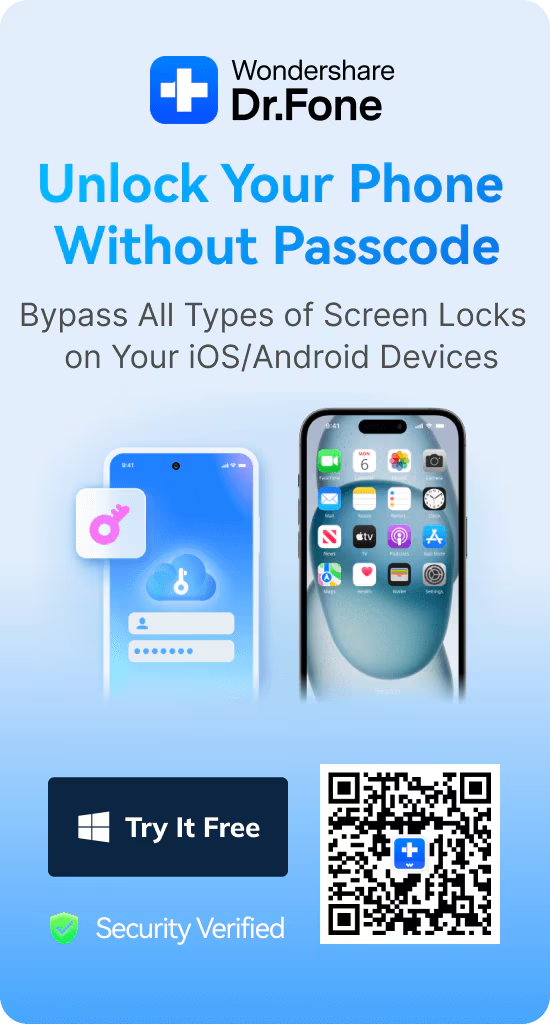

Daisy Raines
staff Editor